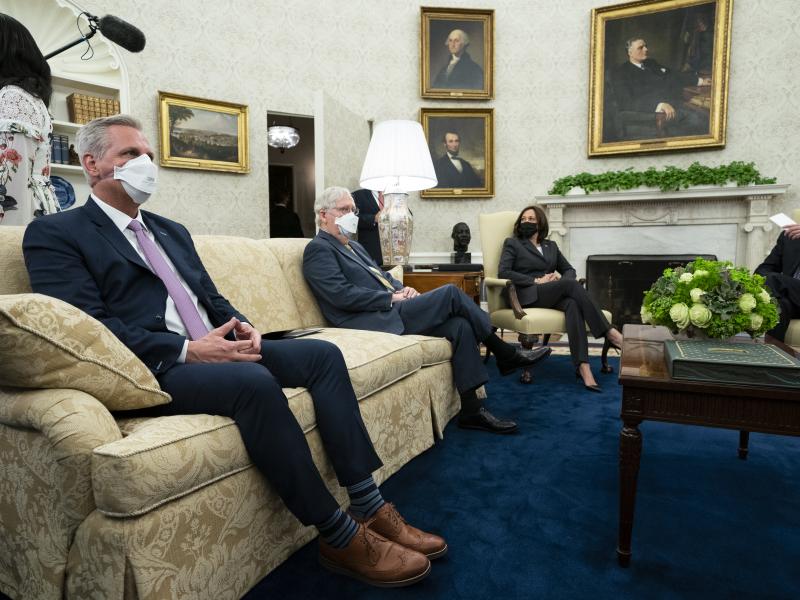
Unlike partisans, who tend to stick with their side in good times and bad, independent voters are willing to criticize or support the party in power based on current events. They aren't living in a movement; they are living in the moment.
As such, when a president's job approval ratings rise or fall dramatically, it's because that president has lost or gained the support of independent voters.
According to Gallup polling, for example, Biden's overall job approval rating has dropped from 57 percent in February to 42 percent today, a slide of 15-points. That drop-off has been driven almost entirely by independent voters. Since February, Biden has lost 6 points of approval among Democrats (96 percent to 90 percent), a similar 6 points among Republicans (from 12 percent to 6 percent), but he has lost 16 points among independents (dropping from 53 percent in February to 37 percent in November).
The most recent polls from Marist, Quinnipiac, Washington Post/ABC, Fox and Monmouth, show Biden's job approval ratings among independents in a similar place; from 29 percent to 44 percent approval. More ominously for Biden, the strong disapproval ratings among independent voters have also increased over these past few months. For example, back in April, 27 percent of independent voters in the Quinnipiac poll said they strongly approved of the job Biden was doing, compared to 38 percent who strongly disapproved. In the November polling, just 12 percent of independents strongly approved to 46 percent who strongly disapproved; a swing of 23 points more strongly negative.
Independent voters are like the "check engine" light in American politics: when that light goes on, you are in trouble. Right now, that light is blinking red. That's a terrible sign not just for Biden but for Democrats writ large.
A president's low approval ratings among independent voters is a key factor in the poor performance by that president's party in the upcoming midterm election. Since 2010, the sitting president entered the fall of the midterm election year with a job approval rating among independents anywhere between 38 and 45 percent. In all three of those midterm elections, the party in the White House lost independent voters by double-digits. And, of course, the party of the president lost control of the House, the Senate or both.
Today, Biden's job approval ratings among independent voters are only slightly higher than Donald Trump's and slightly lower than Obama's standing with independent voters at this point in their presidencies. For example, Trump's job approval rating among independent voters in November of 2017 was 34 percent (just 3 points lower than where Biden is today). Marist had Trump at 34 percent in mid-November compared to 44 percent for Biden earlier this month. Quinnipiac showed Trump at 31 percent with independents in November of 2017, while Biden sits at 29 percent with that group of voters today.
But, unlike Trump, Biden started his presidency with some goodwill among independent voters. From February until June, opinions of Biden among independent voters ranged from 50 percent to 58 percent. Opinions of Trump among independents, meanwhile, were always more negative than positive. In fact, Trump's approval ratings among independent voters never broke out of the mid-to-high 30 percent range for all of 2017 and 2018.
In other words, the opinions of Trump, even among these 'swing' voters were hardened and nothing good or bad moved them very much. Biden, however, has been seen both positively and negatively by independent voters. This suggests that just as he has slipped with these voters, he can also gain with them.
But, just how much ground can he make up? And, how quickly? This month provided some good news for Biden. The most recent polls from Gallup, Fox, Marist and Quinnipiac find Biden recovering some ground — or at least stabilizing — with independent voters. For example, Marist polling found Biden underwater with independent voters in August by 19 points (36 percent approve to 55 percent). Their November poll showed that gap down to 5 points (44 percent approve to 49 percent disapprove). The October FOX poll found Biden losing support among independents by 26 points (36 percent to 62 percent); that gap was 16 points (39 percent to 55 percent) in their November poll.
Of course, there's no telling if this is simply a blip, an outlier or the start of an upward trend.
Recent history, however, suggests that it won't be easy - or speedy — to gain back support from independents. Once the honeymoon ends for many of these voters, it's over. For example, Gallup polling showed that Pres. Obama, like Biden, started with a reservoir of goodwill among independent voters. Like Biden, Obama's approval ratings among those voters also slipped pretty substantially in his first year, from 63 percent in February to 44 percent in November of 2009.
However, it wasn't until October of 2012 that Obama broke into positive territory with independent voters. That improvement helped Obama win re-election. Even so, it was a short-lived gain. Opinions of Obama among independents slipped yet again in 2013 and didn't recover until 2016.
Unlike Trump, Biden has enjoyed positive marks from independent voters throughout his presidency. What we don't know is whether they're willing to give him another chance. That decision will determine just how much ground Biden can make up (or not) before 2022.

Subscribe Today
Our subscribers have first access to individual race pages for each House, Senate and Governors race, which will include race ratings (each race is rated on a seven-point scale) and a narrative analysis pertaining to that race.